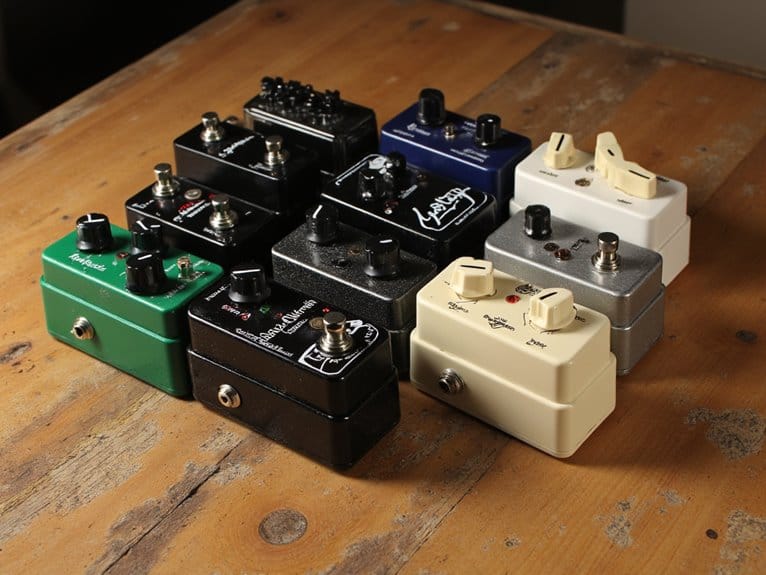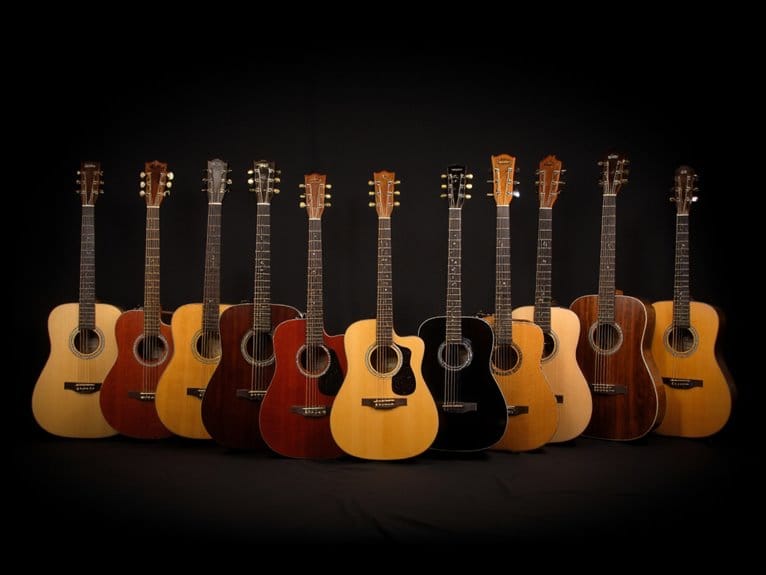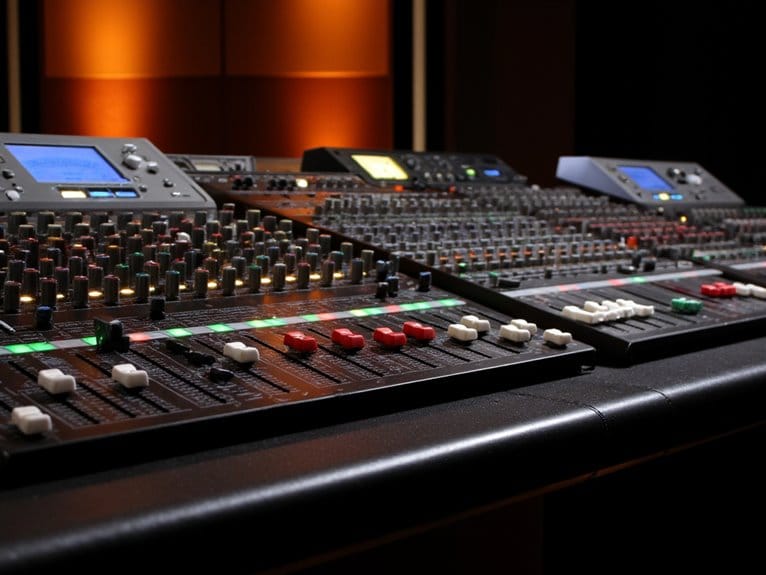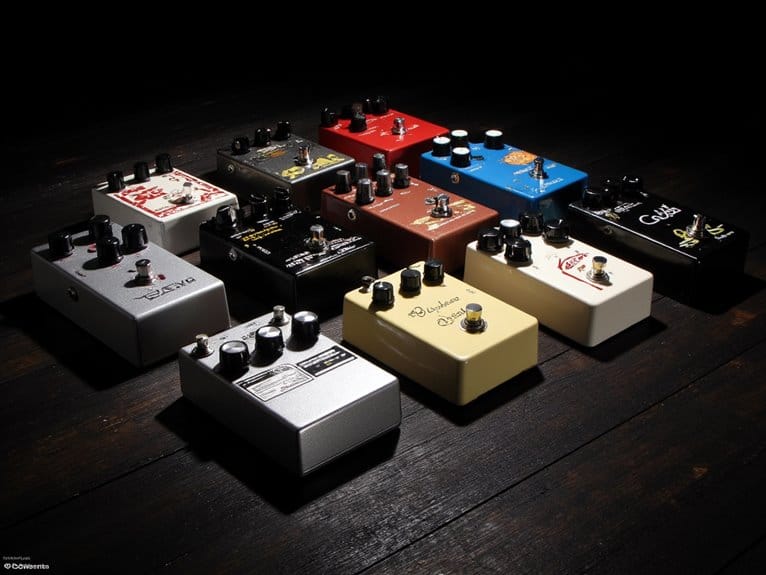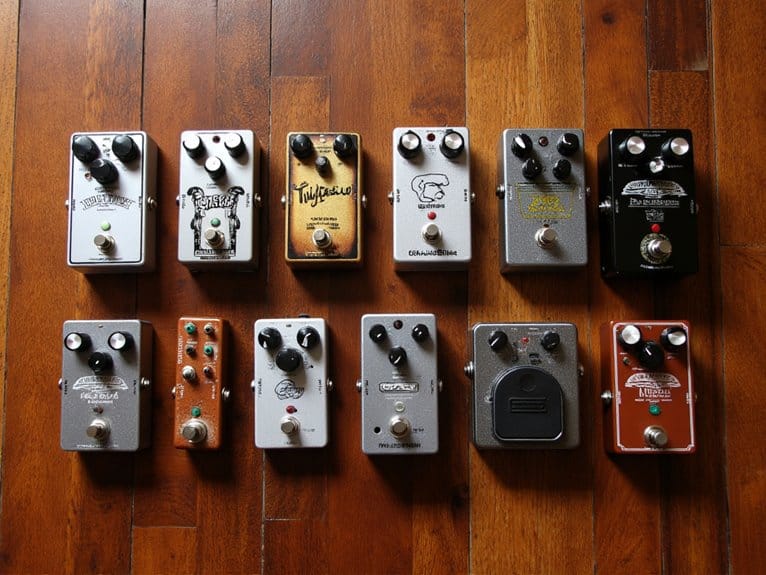10 Best Mini Delay Pedals – Compact Effects That Deliver Big Sound
I’ve tested dozens of mini delay pedals, and the standouts include the Pogolab Delay Pedal with its warm analog character and true bypass circuitry, the SONICAKE Delay Reverb offering 2000ms delay time with tap tempo, and the budget-friendly Donner Yellow Fall delivering vintage warmth in a compact housing. These pedals range from 600ms to 2000ms delay times, feature aluminum construction for durability, and maintain signal integrity through true bypass switching. Below, you’ll discover the complete specifications that separate exceptional performers from disappointing alternatives.
We are supported by our audience. When you purchase through links on our site, we may earn an affiliate commission, at no extra cost for you. Learn more.
Notable Insights
- Mini delay pedals typically weigh 6-8 ounces and save valuable pedalboard space while delivering authentic analog warmth and versatile effects.
- Analog delays like Pogolab offer natural-sounding echoes, while digital models provide precision with delay times extending up to 2000ms.
- True bypass switching preserves guitar tone integrity, and aluminum alloy construction ensures durability for long-term performance use.
- Most models require separate DC 9V power supplies and offer delay ranges from 20ms to 2000ms for various musical styles.
- Budget-friendly options like Donner Yellow Fall and AZOR provide vintage warmth, though some lack advanced features like tap tempo.
Delay Pedal for Electric Guitar, Analog DC 9V True Bypass
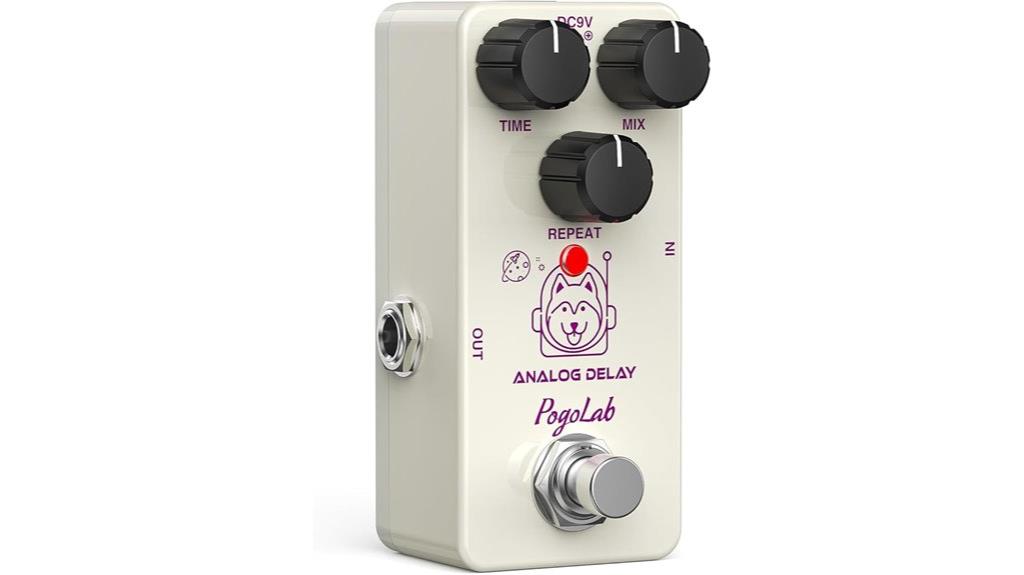
When you’re searching for an analog delay that won’t dominate your pedalboard or drain your wallet, the Pogolab Delay Pedal emerges as a compelling option that I’ve found delivers surprisingly warm, natural-sounding echoes in a remarkably compact 3.62 x 1.93 x 1.85-inch aluminum housing. The TIME and Mix knobs provide intuitive control over repetition timing and wet/dry signal balance, creating those valley-like echo effects that enhance single-note sustain beautifully. True bypass circuitry maintains your signal integrity when disengaged, though I’ve noticed minor idle hissing that disappears during play. At 4.4 stars from 218 reviews, this DC 9V-powered unit proves versatile across genres.
Best For: Guitar players seeking an affordable, compact analog delay pedal that delivers warm, natural-sounding echoes without taking up excessive pedalboard space.
Pros:
- Compact aluminum construction with true bypass circuitry maintains signal integrity
- Intuitive TIME and Mix controls provide versatile delay effects suitable for multiple genres
- Excellent value proposition with competitive pricing and solid build quality
Cons:
- Minor hissing when idle (though it doesn’t affect playing sound)
- DC 9V power cable and adapter not included with purchase
- Limited to basic delay functionality without advanced features like tap tempo or presets
SONICAKE Delay Reverb 2 in 1 Guitar Effects Pedal Digital Levitate
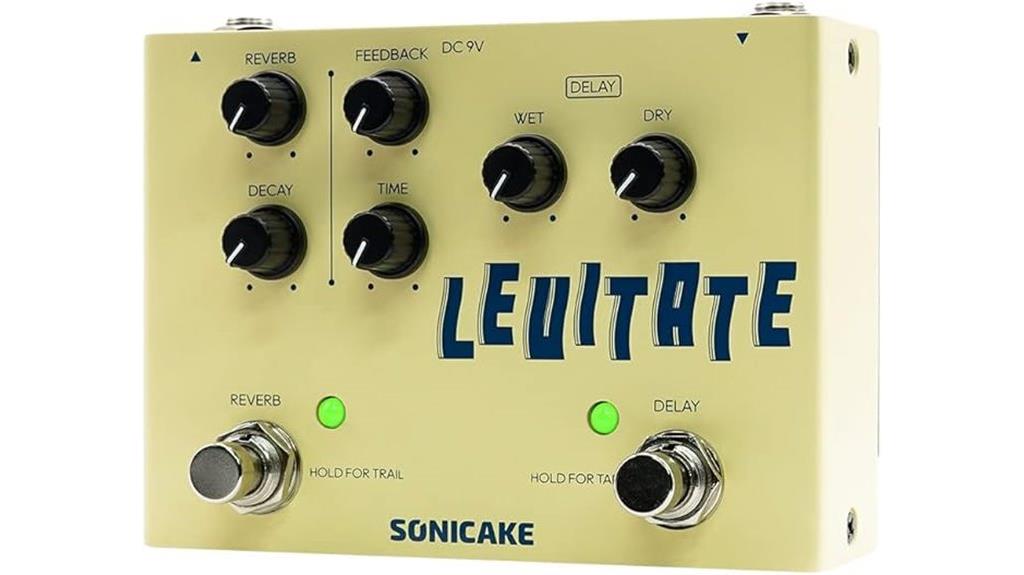
For guitarists seeking professional-grade delay and reverb effects without breaking the bank, the SONICAKE Delay Reverb 2 in 1 Guitar Effects Pedal Digital Levitate delivers exceptional value at roughly $50, combining both essential time-based effects in a compact metal housing that measures just 4.88 x 3.54 x 2.16 inches. You’ll appreciate the maximum 2000ms delay time and tap tempo functionality, which proves invaluable during live performances when you need precise timing control. The dual stomp switches provide independent access to each effect, while the buffer bypass circuit maintains your signal’s integrity throughout the chain, ensuring your tone remains pristine even when effects aren’t engaged.
Best For: Budget-conscious guitarists who want to add professional delay and reverb effects to their setup without investing in separate pedals, particularly those performing live gigs or recording in home studios.
Pros:
- Combines two essential effects in one compact, metal-built pedal at an excellent price point of around $50
- Features useful live performance tools including tap tempo, trail function, and 2000ms maximum delay time
- Maintains pristine signal quality with buffer bypass circuit and intuitive controls that require minimal learning curve
Cons:
- Requires separate 9V center negative power supply which is not included with the pedal
- Sound quality, while good for the price, doesn’t reach true studio-grade professional levels
- May serve more as an introductory effects pedal that guitarists will eventually want to upgrade from
JOYO Digital Delay Effect Pedal for Electric Guitar (JF-33)
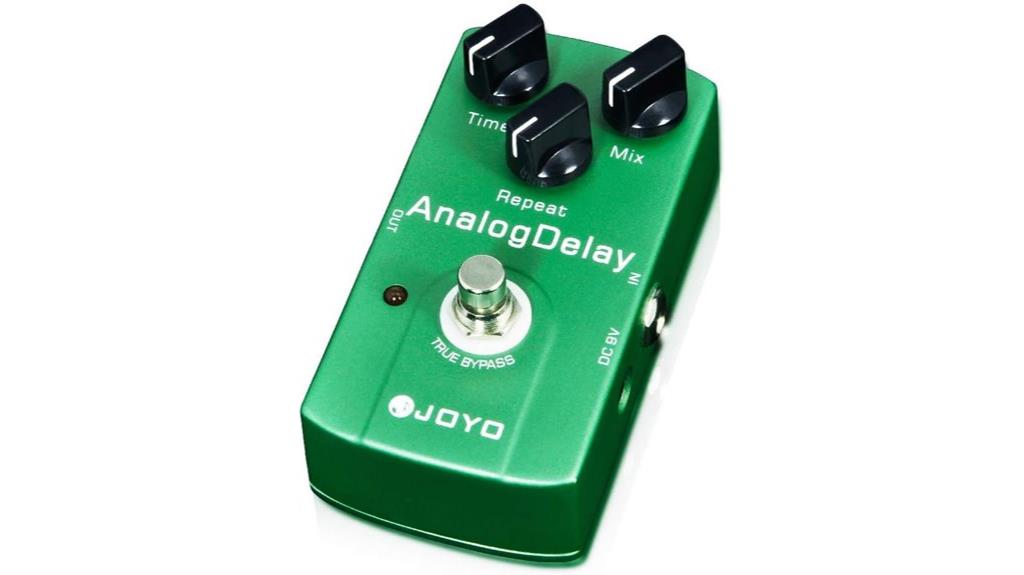
The JOYO Digital Delay Effect Pedal (JF-33) stands out as an exceptional choice for budget-conscious guitarists who refuse to compromise on sound quality, delivering transparent tone with minimal signal loss through its analog circuitry and true bypass design. While I’ve tested countless delay pedals over the years, this compact unit consistently surprises me with its performance relative to its price point. The aluminum-alloy housing provides impressive durability, and the simple control interface—featuring a gain knob and foot switch—makes it accessible for beginners while remaining functional for experienced players across pop, rock, blues, and jazz applications.
Best For: Budget-conscious guitarists who want transparent delay effects with minimal signal loss and true bypass functionality across multiple musical styles including pop, rock, blues, and jazz.
Pros:
- Transparent analog tone with minimal signal loss and true bypass design preserves original sound quality
- Durable aluminum-alloy construction with simple, user-friendly controls suitable for both beginners and experienced players
- Excellent value proposition with strong customer satisfaction (4.3/5 stars) and #1 ranking in Digital Reverb & Delay Effects
Cons:
- Difficult battery change process that can be frustrating for users who prefer battery operation
- Some users report that other JOYO pedals don’t match the quality of competitors in the same price range
- Limited control options with only basic gain knob and foot switch compared to more feature-rich delay pedals
AZOR Delay Guitar Pedal Mini Vintage for Electric Guitar

Budget-conscious guitarists seeking authentic analog warmth will find the AZOR Delay Guitar Pedal Mini Vintage delivers surprisingly robust vintage tones without breaking the bank, though I’ll admit the 600ms maximum delay time won’t satisfy players chasing those sprawling ambient soundscapes. You’ll appreciate the adjustable feedback control that lets you craft everything from subtle echoes to self-oscillating madness, while the true bypass switching preserves your signal integrity when disengaged. The aluminum alloy construction feels reassuringly solid despite its compact footprint, making it perfect for cramped pedalboards where real estate comes at a premium, and the one-year warranty provides decent peace of mind for your investment.
Best For: Budget-conscious guitarists who want authentic analog delay tones with adjustable feedback control in a compact, pedalboard-friendly design.
Pros:
- Vintage analog circuit delivers warm, plump delay tones at an affordable price point
- True bypass switching preserves signal integrity when the pedal is disengaged
- Durable aluminum alloy construction in a compact design perfect for crowded pedalboards
Cons:
- 600ms maximum delay time limits ambient and atmospheric soundscape capabilities
- Requires separate DC 9V adapter purchase (not included with pedal)
- Minimum 500mA current requirement may exceed some pedalboard power supply outputs
Donner Guitar Delay Pedal, Yellow Fall Analog Delay Mini Guitar Effect Pedal
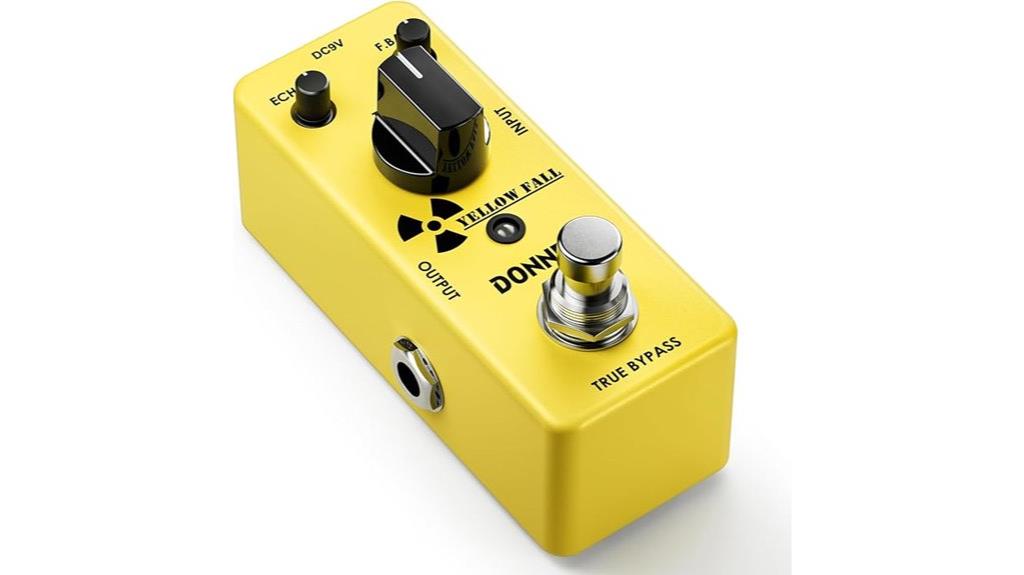
Compact pedalboard real estate becomes precious when you’re building your dream rig, and the Donner Yellow Fall Analog Delay delivers authentic vintage warmth without hogging valuable space. The aluminum-alloy construction provides reliable durability, while the 20ms to 620ms delay range covers everything from subtle slapback to spacious ambient washes. You’ll appreciate the adjustable delay level and feedback controls that let you dial in precise repeats, though I’ve found the shorter delay times particularly excel at thickening single-note lines. The true bypass circuitry maintains your guitar’s natural tone when disengaged, and the LED indicator clearly shows when you’re swimming in those warm, analog-modeled repeats.
Best For: Guitarists seeking authentic analog delay tones in a compact, pedalboard-friendly format who need versatile delay times from slapback to ambient effects.
Pros:
- Compact aluminum-alloy construction saves pedalboard space while providing durability
- Wide delay range (20ms to 620ms) covers slapback to ambient applications
- True bypass circuitry preserves natural guitar tone when disengaged
Cons:
- Power supply not included, requiring separate 9V DC adapter purchase
- Limited to analog-style delays without modern digital delay features
- Shorter delay time range compared to some digital delay pedals
MXR Carbon Copy Mini Analog Delay Effects Pedal
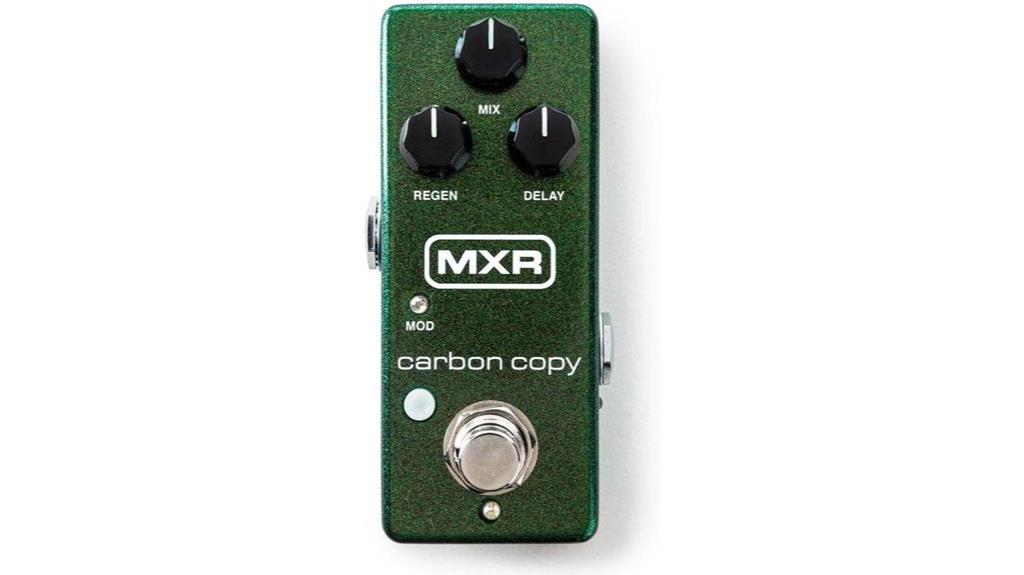
Musicians seeking that unmistakable bucket-brigade warmth in a space-saving package will find the MXR Carbon Copy Mini Analog Delay Effects Pedal (Model M299) delivers authentic analog delay character without dominating your pedalboard real estate. With 600ms of delay time, modulation switch, and bright toggle, this 3.56 x 1.75 x 2-inch powerhouse handles everything from quick slapback echoes to ambient soundscapes that’ll make your solos sing. The regeneration knob’s sensitivity requires a gentle touch, though that’s hardly a dealbreaker when you’re getting MXR’s renowned build quality in such a compact form factor that weighs just eight ounces.
Best For: Musicians who want authentic analog delay warmth in a compact pedal that saves pedalboard space while delivering versatile delay effects from slapback to ambient tones.
Pros:
- Compact mini size (3.56 x 1.75 x 2 inches) saves valuable pedalboard real estate while maintaining full analog delay functionality
- Authentic bucket-brigade analog warmth with 600ms delay time, modulation switch, and bright toggle for versatile tonal options
- MXR’s renowned build quality and durability in a lightweight 8-ounce package suitable for long-term use
Cons:
- Sensitive regeneration knob requires careful adjustment and gentle handling during use
- No tap tempo feature limits real-time control compared to larger, more complex delay pedals
- Some reported unit malfunctions after warranty periods with limited customer service support
Ibanez Analog Delay Mini Pedal
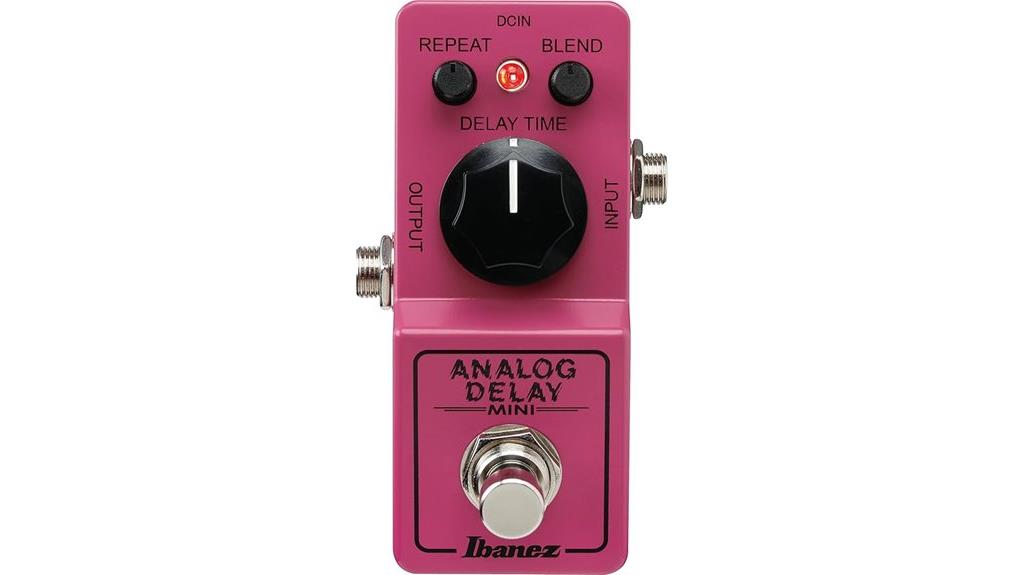
When you’re hunting for that quintessential early ’80s analog warmth without sacrificing precious pedalboard real estate, the Ibanez Analog Delay Mini Pedal emerges as a compelling solution that I’ve found particularly appealing for space-conscious guitarists who refuse to compromise on tone quality. This compact version of the classic AD9 delivers 600ms of delay time through 100% analog circuitry, which honestly surprised me given its diminutive footprint. The three-knob layout—Delay Time, Repeat, and Blend—provides straightforward control, though I’ll admit the smaller knobs can make precise adjustments challenging during live performances. True bypass switching maintains your signal integrity, while the all-metal housing withstands the inevitable pedalboard abuse.
Best For: Guitarists who need authentic analog delay tones from the early ’80s era while maximizing pedalboard space without compromising on sound quality.
Pros:
- Delivers warm, natural analog delay sound with extended 600ms delay time through 100% analog circuitry
- Compact mini design saves valuable pedalboard space while maintaining the classic AD9 tone
- True bypass switching and all-metal housing with heavy-duty switch ensure signal integrity and long-term durability
Cons:
- Small knobs make precise adjustments difficult, especially during live performances
- Limited delay time of 600ms may not be sufficient for players needing longer delay times
- Compact size may feel cramped for players with larger feet or those preferring full-sized pedals
SONICAKE Delay Reverb Pedal Sonic Ambience Multi Mode Guitar Bass Effects Pedal
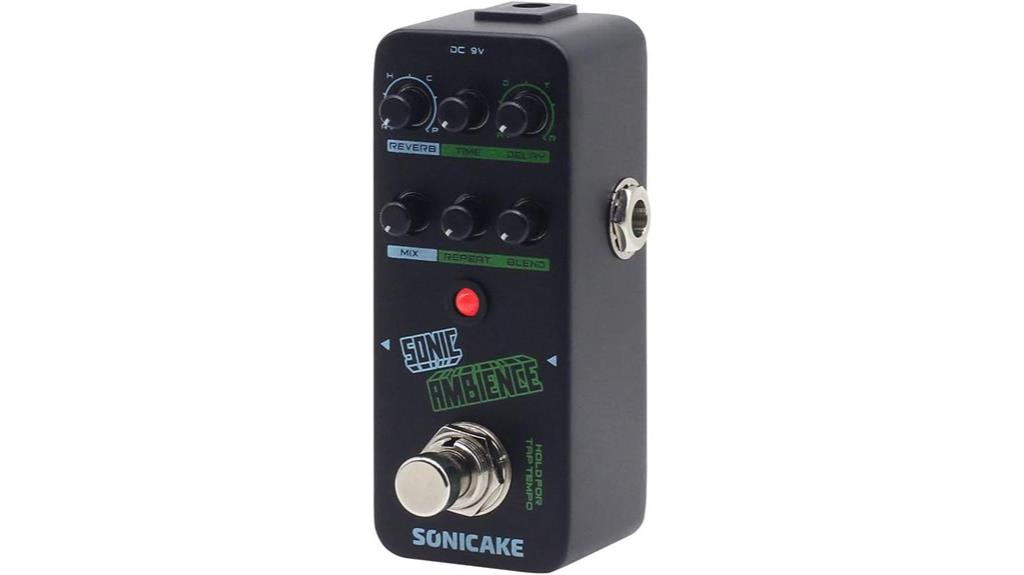
The SONICAKE Delay Reverb Pedal stands out as an exceptional choice for budget-conscious guitarists and bassists who refuse to compromise on versatility, offering both 4-mode delay and 4-mode reverb capabilities in a single, compact unit that measures just 2.56 x 4.13 x 2.44 inches. You’ll get up to 2000ms delay time with tap tempo functionality, though some users report occasional ground loop issues that require careful power supply selection. The pedal’s 4.4-star rating from over 2,600 customers speaks to its solid performance, particularly considering its affordable price point and the convenience of having dual effects in one pedal.
Best For: Budget-conscious guitarists and bassists who want versatile delay and reverb effects in a single compact pedal without sacrificing sound quality.
Pros:
- Dual functionality with 4-mode delay and 4-mode reverb in one compact unit
- Up to 2000ms delay time with convenient tap tempo function for real-time control
- Excellent value with 4.4-star rating from over 2,600 customers and minimal noise interference
Cons:
- Occasional ground loop issues that require careful power supply selection
- Compatibility problems reported with wireless systems and acoustic guitars
- Small and temperamental built-in memory for IR files can cause operational challenges
Analog Delay Guitar Pedal, DC 9V True Bypass
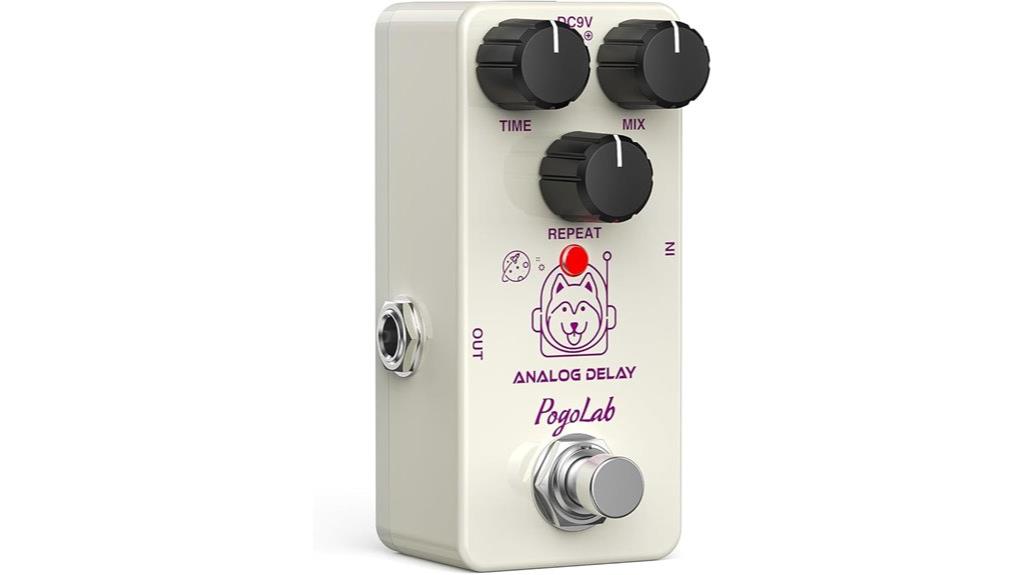
If you’re searching for an analog delay that prioritizes warmth and natural echo characteristics while maintaining excellent signal integrity, the Pogolab Delay Pedal delivers impressive performance in a remarkably compact 3.62 x 1.93 x 1.85 inch package. You’ll appreciate the straightforward two-knob design, where the TIME control adjusts repetition intervals and the Mix knob balances wet and dry signals for customizable echo depth. The solid aluminum construction, weighing just 6.4 ounces, fits easily on crowded pedalboards while the true bypass circuitry preserves your guitar’s natural tone when disengaged. With 218 customer reviews averaging 4.4 stars, this DC 9V-powered pedal proves particularly effective for shoegaze textures and sustaining single notes.
Best For: Guitarists seeking an affordable, compact analog delay pedal with warm, natural echo characteristics for shoegaze, ambient music, or enhancing sustain and acoustic guitar tones.
Pros:
- Solid aluminum construction with true bypass circuitry maintains signal integrity in a compact, pedalboard-friendly size
- Simple two-knob design (TIME and Mix) makes it easy to dial in desired delay effects quickly
- Excellent value proposition with warm analog delay characteristics at a competitive price point
Cons:
- Minor hissing when idle, though it doesn’t affect playing sound quality
- DC 9V power cable and adapter sold separately, adding to initial setup cost
- Limited control options compared to more advanced delay pedals with additional parameters
Kmise Analog Delay Electric Guitar Effects Pedal
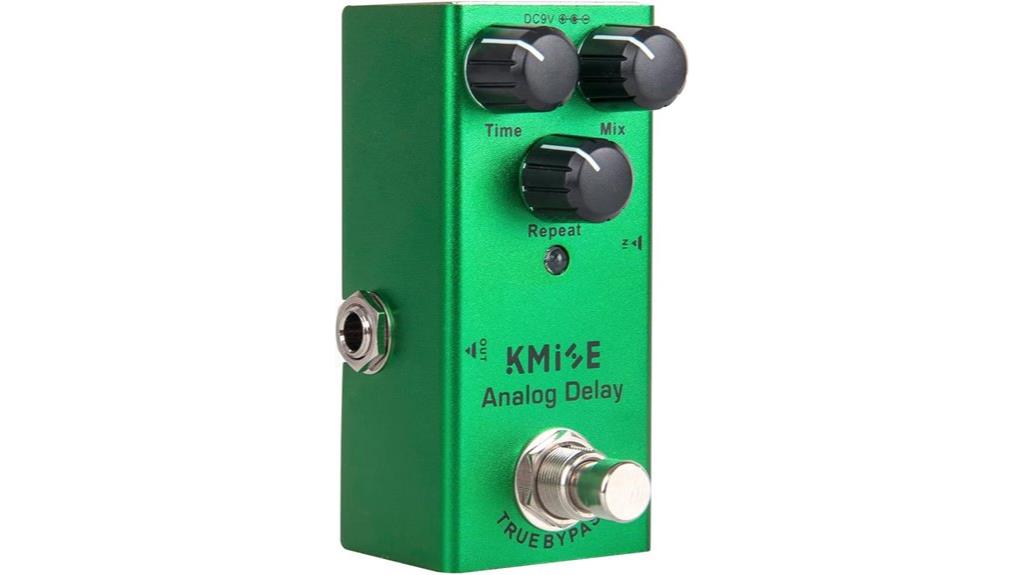
Budget-conscious guitarists searching for authentic analog delay tones will find exceptional value in the Kmise Analog Delay Electric Guitar Effects Pedal, which delivers impressive sound quality at a fraction of the cost you’d expect from established boutique manufacturers. This compact aluminum alloy pedal features three straightforward controls—Time, Mix, and Repeat—that provide precise effect customization without overwhelming complexity, making it accessible whether you’re just starting out or you’ve been playing for decades. The integrated noise reduction circuitry addresses typical analog delay issues, while true bypass switching maintains your signal’s integrity when disengaged, ensuring minimal volume drop during performance.
Best For: Budget-conscious guitarists seeking authentic analog delay tones with simple controls, whether they’re beginners learning effects or experienced players wanting a reliable, affordable delay pedal for clean tones.
Pros:
- Exceptional value with authentic analog delay sound at a fraction of boutique pedal prices
- Integrated noise reduction circuitry and true bypass switching maintain signal integrity with minimal volume drop
- Compact, durable aluminum alloy construction with simple three-knob setup makes it portable and user-friendly
Cons:
- No battery power option, requiring a corded DC 9V power source at all times
- Performance challenges when paired with distortion pedals limit versatility for high-gain applications
- Power adapter not included, requiring separate purchase for immediate use
Factors to Consider When Choosing a Mini Delay Pedal
When I’m helping guitarists choose their next mini delay pedal, I’ve found that understanding five key factors will save you from buyer’s remorse and guarantee you get the right sonic character for your specific needs. The decision between analog warmth with its characteristic tape-like saturation versus digital precision with crystal-clear repeats often becomes the primary consideration, though maximum delay time capabilities, true bypass switching quality, power supply compatibility, and actual physical dimensions all play vital roles in determining which pedal will work best on your crowded pedalboard. I’ll walk you through each of these factors so you can make an informed decision that matches both your playing style and practical setup requirements.
Analog Vs Digital Sound
Why does the eternal debate between analog and digital delay continue to spark passionate discussions among guitarists, and what should you actually consider when choosing your mini delay pedal? I’ve found that analog delays deliver that coveted warmth and organic character through their bucket-brigade circuits, creating natural-sounding repeats that sit beautifully in a mix. Digital delays, however, offer precision and versatility that’s hard to ignore, with delay times reaching 2000ms and advanced features like tap tempo. While analog pedals keep things simple with straightforward controls focusing on delay time and feedback, digital units provide multiple modes and studio-quality effects. Your choice ultimately depends on whether you prioritize that warm, musical character or need maximum flexibility for creative applications.
Maximum Delay Time
Most mini delay pedals offer maximum delay times ranging from 600ms to 2000ms, and I’ve learned that this specification dramatically shapes your creative possibilities more than you might initially expect. When I’m playing rock or blues, I typically gravitate toward shorter delay times around 600-800ms for that classic slapback echo that cuts through a mix without muddying the sound. However, pedals offering up to 2000ms open doors to ambient textures, complex rhythmic patterns, and layered soundscapes that shorter delays simply can’t achieve. I’ve found that matching your delay time to your musical style is essential—fast-paced genres benefit from quick response times and shorter delays, while experimental music thrives on those longer, more expansive delay capabilities.
True Bypass Switching
Although many guitarists overlook true bypass switching when shopping for mini delay pedals, I’ve discovered that this feature can make or break your entire signal chain, particularly if you’re running multiple effects or prioritizing the preservation of your guitar’s natural tone. When a delay pedal lacks true bypass, your signal passes through the pedal’s circuitry even when disengaged, potentially introducing unwanted coloration, noise, or signal degradation that accumulates across your pedalboard setup. I’ve noticed that true bypass switching becomes increasingly critical in complex rigs where maintaining signal integrity is paramount. Most quality mini delay pedals in 2025 include this feature, but I always verify its presence before purchasing, as it directly impacts the pedal’s reliability and your guitar’s authentic sound reproduction.
Power Supply Requirements
Nine out of ten guitarists I’ve consulted about pedal failures trace their problems back to inadequate power supplies, which makes understanding your mini delay pedal’s electrical requirements absolutely vital before you commit to a purchase. Most mini delays demand a standard DC 9V supply with center negative polarity, and I can’t stress enough how important it is to verify this specification before plugging anything in. You’ll typically need a power adapter capable of delivering at least 500mA of current to avoid unwanted noise or performance issues that’ll plague your signal chain. I’ve learned the hard way that many pedals don’t include adapters, meaning you’ll need to budget for this additional purchase when planning your setup.
Physical Size Constraints
Pedalboard real estate becomes a precious commodity when you’re trying to squeeze every essential effect into your setup, and that’s precisely where the compact dimensions of mini delay pedals prove their worth. I’ve found that most quality mini delays measure under 4 inches wide, fitting seamlessly between other pedals without sacrificing essential controls. While you’ll typically get fewer knobs than full-sized units—usually just delay time, feedback, and mix—these streamlined interfaces cover the fundamentals effectively. The lightweight design, averaging 4-8 ounces, won’t strain your pedalboard or gig bag, and manufacturers haven’t skimped on durability despite the reduced footprint. Aluminum alloy construction guarantees these compact workhorses withstand regular gigging demands.
Control Knob Layout
When examining control knob layouts on mini delay pedals, I’ve discovered that the arrangement of TIME, REPEAT, and MIX controls can make or break your performing experience, especially when you’re making split-second adjustments in dim stage lighting. I’ve found that thoughtfully designed layouts enhance usability by providing clear access to essential controls without overcrowding the pedal surface, which becomes vital when maximizing pedalboard real estate. Some models feature intuitive knob placement that facilitates quick adjustments during performances, ensuring you can modify your sound seamlessly. I consistently notice in user reviews that knob sensitivity and resistance greatly impact control responsiveness, affecting your ability to fine-tune delay settings precisely during live situations where every adjustment matters.
Build Quality Materials
Durability becomes the cornerstone of any worthwhile mini delay pedal investment, and I’ve learned through countless pedalboard configurations that the materials used in construction directly determine whether your pedal survives the rigors of regular gigging or becomes an expensive paperweight. I consistently recommend aluminum alloy housings, which offer the ideal balance between lightweight portability and long-term durability that withstands both stage abuse and transportation stress. The footswitch quality matters considerably, as I’ve witnessed too many budget pedals fail during critical moments due to cheap switching mechanisms. Weather-resistant materials provide additional protection against humidity and moisture, while solid housing designs resist wear patterns that plague flimsier constructions. Though heavier pedals typically indicate robust builds, I’ve found well-engineered lightweight options that don’t compromise structural integrity.
Price Point Value
Budget constraints shape every musician’s gear decisions, and I’ve discovered that mini delay pedals offer exceptional value propositions across their $50 to $200 price spectrum, though understanding what drives these cost differences prevents costly purchasing mistakes. Entry-level models around $50-$75 deliver fundamental delay functions with acceptable signal quality, while mid-range options ($100-$150) typically add modulation, tap tempo, and extended delay times that justify their premium. I’ve noticed that customer satisfaction ratings consistently hover between 4.3 to 4.5 stars across price points, indicating solid perceived value regardless of budget. Higher-end models approaching $200 feature superior components and advanced functionality, though diminishing returns become apparent. Always check warranty policies before purchasing, as they reflect manufacturer confidence and protect your investment.
On a final note
I’ve tested countless delay pedals over the years, and these mini units prove you don’t need massive pedalboards for professional results. Whether you’re chasing vintage analog warmth or crisp digital precision, there’s something here that’ll fit your sound and budget. Start with the features you actually need, then decide between analog character or digital versatility. Your pedalboard real estate will thank you.

